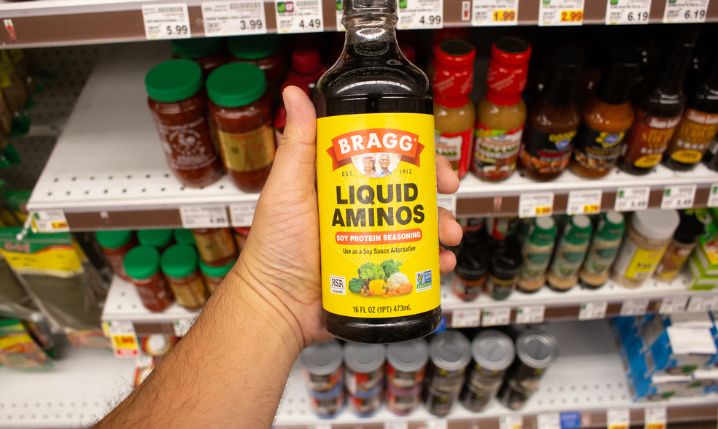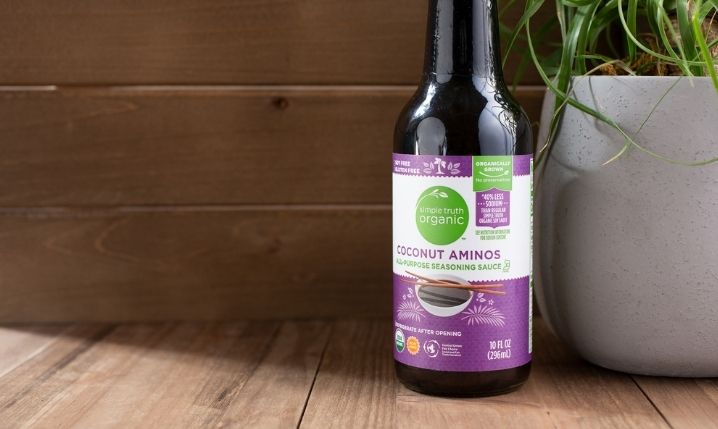Many sauces are available out there, with many being recommended as substitutes for each other. You might be curious about the differences between some of them. That includes the often confused liquid aminos and coconut aminos. In this article, we’re comparing liquid aminos vs. coconut aminos so you can find out everything you need to know.
Contents:
What Are Liquid Aminos?

Liquid Aminos are a condiment/sauce made by Bragg that is often used as a condiment, marinade, or dipping sauce. It’s made from soybeans and purified water.
This sauce is often used as a replacement for soy sauce in East Asian cuisine because of its savory, umami flavor.
Liquid Aminos are visually a dark rich brown; the sauce has a thin consistency similar to soy sauce and coconut aminos.
They are often recommended as a substitute for other sauces because of being gluten-free, MSG-free, and vegan.
You can use liquid aminos as a seasoning sauce, dipping sauce, or marinade sauce. This means you can use it for cooking stir-fries, dipping sushi, or even seasoning chicken as part of a marinade or similar.
What Are Coconut Aminos?

Coconut aminos is a popular sauce used for seasoning, dipping, and dressing foods. It’s one of several sauces recommended for dozens of recipes in Asian cuisine, especially Chinese and Japanese cuisine.
Despite what some think, coconut aminos do not taste like coconut. This is because they’re made by fermenting coconut-blossom nectar, which is then blended with sea salt to create a rich, intense umami flavor.
As coconut aminos do not contain soybeans, they’re soy-free, making it the ideal sauce for anyone with soy intolerances or allergies. Additionally, coconut aminos are also gluten-free and MSG (Monosodium Glutamate) free.
The consistency of the sauce is thin, and the color is a deep and dark brown. The taste is most similar to soy sauce as coconut aminos are saltier than similar sauces like liquid aminos.
You can use coconut aminos for stir-fries, noodles, dressings, dips, marinades, and much more.
What’s The Difference Between Liquid Aminos and Coconut Aminos?
| Liquid Aminos | Coconut Aminos |
|---|---|
| Created from soybeans and purified water. | Created from coconut-blossom nectar. |
| Gluten-free, MSG-free, Vegan-friendly | Gluten-free, MSG-free, Vegan-friendly, Soy-free. |
| Savory, sweet, mildly salty flavors. | Savory, sweet, mildly salty flavors. |
| Thin consistency. | Thin consistency. |
The primary difference between liquid and coconut aminos is that coconut aminos aren’t made from soybeans, making them a perfect alternative to soy-based sauces like liquid aminos.
The taste and flavor are incredibly similar, but there are subtle differences in terms of sweetness and saltiness between the two. Liquid aminos aren’t quite so salty or sweet as coconut aminos, so always keep that in mind.
- Consistency: Both liquid and coconut aminos have an overall thin consistency that is similar to regular soy sauce.
- Appearance: They are both dark brown in color, making them look black in some light.
- Taste and flavor: Liquid aminos aren’t as salty or sweet as coconut aminos, but it’s hard to detect the difference unless you have the most sensitive palette.
- Culinary uses: You can use liquid aminos and coconut aminos interchangeably for one another in various East Asian recipes because of the similar taste and consistency.
Conclusion
Both liquid and coconut aminos are popular sauces used in various recipes, especially Asian recipes, as they’re often recommended as alternatives for soy sauce. They have a similar appearance, taste, and consistency. You’ve also learned that they’re both gluten-free, vegan, and MSG-free.
However, one big difference is that coconut aminos are soy-free. It should also be noted that liquid aminos are the better option if you’re on a low-sodium diet.